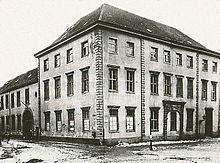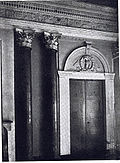Hondheim Palace
The Hondheimsche Palais was a historic building complex on the corner of Akademiestraße and Dammstraße in Düsseldorf , which no longer exists today, and which was destroyed in World War II.
history
The double building was built between 1709 and 1713 by Matteo Alberti at the instigation of Elector Johann Wilhelm for the General War Commissariat. At that time the building was located between Rheintor and Hafenstrasse on Kommissariatstrasse (formerly “eighth of the wall at Bergerthor [behind the wall from Berger Tor ]”) and consisted of two wings. At the back was the old port of Berger . In addition to the Kommissariat , which was also the godfather for the name Kommissariatsstraße , the Palatinate central authorities and the Secret Chamber Chancellery were also housed in these buildings. After the authorities were relocated, their head, Freiherr Lothar Friedrich von Hondheim (also spelled Hontheim or Huntheim), acquired the property. After von Hondheim relinquished the building to the authorities at the time for financial reasons, it later served a wide variety of uses, for example a ballroom was also available at times.
In 1752 the “Royal Arrest and Corrections House ” was set up in the west wing . In 1782, Elector Carl Theodor left a part, the left part of the double building, to Lambert Krahe for the Electoral Academy of Fine Arts in Düsseldorf , which was located there until 1806, as well as a copper printing works in Hafenstrasse 4. One of the better-known inspectors of the Electoral Picture Gallery was after Krahe Johann Christian Alois Cornelius , the father of the painter Peter Cornelius , who also lived in the palace for a while. It is said of Cornelius that he was disturbed by "terrible noise" in an adjacent elementary class while working on a painting. At the subsequent call to order, he grabbed the first available student and broke his cane on his back. The young student who was moved was Heinrich Heine .
In view of the new use, the street name was changed to Akademiestraße in the middle of the second half of the 18th century . In 1810 the academy was outsourced and the Ministry of the Interior of the Grand Duchy of Berg followed . After the end of the French era , judicial authorities followed again with peace and criminal courts and a prison, to which Ferdinand Lassalle was brought after arrest in November 1848 . From 1841 to 1867 Friedrich Eduard Gerst was the prison pastor. In the vernacular he was only briefly called Pastor Jääsch . A plaque reminds of him at the former entrance with the remains of the wall at Schulstrasse 2a in front of the film museum . In his memory, after the reconstruction of the area around the newly created Berger Hafen , the access between the Hetjens Museum and the city administration building was named Pastor-Jääsch-Weg . When the Berger Hafen (old security port), which extended in the area of Hafenstrasse - between the old town and the citadel - was filled in, it was separated from the Rhine by a dam, on which the no longer existing Dammstraße was laid in 1831 . This connected the Akademiestrasse with the Schulstrasse.
With the police ordinance concerning the designation of the streets and the numbering of the houses in Düsseldorf of July 20, 1858 (house number concordance), the southern side of Akademiestrasse was given No. 1 (previously 1219) for the detention center, No. 3 (previously No. 1219) for the Friedensgericht and No. 5 (formerly No. 1211, east wing) for the District Court . From 1874 to 1879, the Historical Museum was housed in No. 5 on the corner of Hafenstrasse . In 1872 the first professional fire brigade in Düsseldorf had its domicile in the east wing. When the judiciary and the prison moved out at the beginning of the 20th century , administrative offices were set up again in the west wing.
The palace was destroyed in an air raid on the night of April 23-24, 1944. After the war, a new building complex was built on the current corner of Akademie- and Hafenstrasse. Various authorities, such as first the city tax office and then the municipal institute for data processing and communication authorities, had and still have their headquarters here.
description
Paul Sültenfuss describes the interiors designed by Adolph von Vagedes in the style of the Empire :
“The same note can also be seen in his [Vagedes] interior design creations. He had to repair some of the rooms in the Hondheim Palace for the Bergische government. How different the hall architecture he created there compared to the tamer classicism in the round garden hall and the vestibule in Benrath. Plastically drawn and modeled composite capitals and the profile of the rich entablature with their sima, geison, egg stick and tooth cut, frieze, architrave, etc. [...] Delicate empire decorations of delicate charm. "
Josef Kleesattel also saw the hall and describes it in the state of disintegration:
“One has the same feeling when looking at the hall of the old academy at that time, once the palace of the Baron von Hondheim. It is a magnificent hall from the Empire period , an excellent achievement of the stucco work. The walls are structured by pilasters and columns with rich capitals; The French eagle in a laurel wreath is artfully worked over the doors. The cornices, the cove of the ceiling, the ceiling itself are richly ornamented and modeled with great delicacy. Unfortunately, this room is used as the dormitory of the city's fire fighters, a clear sign of indifference to old works of art. The walls of the hall are already badly spoiled, half of the beautiful stucco ceiling fell down a few years ago. Wouldn't it be high time that the protective hand came as soon as possible, which understandingly and piously protected the artfully furnished hall from further ruin. "
Web links
- Foundation of the art academy - 1762 (annual entry for Düsseldorf timeline): “Around 1762 Wilhelm Lambert Krahe founded a drawing school. After several moves, the institution, which, according to Krahe, had been called the Academy since around 1767, was housed in the Palais Hontheim in 1783 in what was then known as Akademie-Strasse. "
- State capital Düsseldorf - The Akademiestraße
- State capital Düsseldorf - Dammstrasse
literature
- Theo Lücker: Stones speak. Small signpost through Düsseldorf's old town . Verlag T. Ewers, Düsseldorf 1977, pp. 114-116 [No. 59 Et Kaschott].
Individual evidence
- ↑ Development plan 5376/033 "Dammstrasse / Schulstrasse" - Düsseldorf
- ↑ http://www.duesseldorf.de/stadtarchiv/stadtgeschichte/gestern_heute/data_bilddokumentation_detail/052_2.shtml
- ^ Contributions to the history of the Lower Rhine, Volume 3, Düsseldorfer Geschichtsverein, 1888, p. 421
- ↑ Hugo Weidenhaupt (Ed.): Düsseldorf history from the origins to the 20th century. Volume 2 From the royal seat to the official city (1614–1900) . Schwann 1988, ISBN 3-491-34222-8 , p. 70
- ^ Ottomar Moeller: The building history of Düsseldorf, The Hontheimer Hof , history of the city of Düsseldorf , Düsseldorfer Geschichtsverein, Düsseldorf, 1888 pp. 378–379
- ↑ Mixed news: "... copperplate engravings can be inspected daily ...", R. Sartori, copper printer at the Electoral Academy, Havenstrasse SBN158 , in Gülich and Bergische weekly news, no. 19.1798
- ↑ "... and No. 4 (Hafenstrasse) belonged to the house next door on Akademiestrasse. ” , In Heinrich Ferber : Historical walk through the old city of Düsseldorf , Delivery II, 1890, p. 72
- ↑ Alfons Houben, in: Düsseldorf How it was then - how it is today , 1983, WI-Verlag, p. 166.
- ↑ From Düsseldorf, of November 23, 1848 , in Düsseldorfer Journal and Kreisblatt (No. 307), of November 24, 1848
- ↑ Drawing Pastor Jääsch in front of the Strafhotel , from pastor-jaeaesch.de
- ↑ Searching for traces: The first Düsseldorf city prison , by the Catholic Prison Association, on lokalkompass.de, accessed on March 16, 2018
- ↑ Internet portal / Düsseldorf / Stadtarchiv, under: Schulstrasse .
- ↑ Heike Blumreiter (Ed.): The Düsseldorf Police Ordinance of 1858, The old and new house numbers, With an introduction to the development of house numbering in the late 18th and early 19th centuries , Stadtarchiv Düsseldorf, Volume 12, Düsseldorf, 2005, ISBN 3 -926490-11-X
- ↑ History of the Stadtmuseum Düsseldorf: Decision to found a historical museum by the city council, May 5, 1874, location: Palais Hontheim, fire station, Akademiestraße 5 (today Hafenstraße)
- ↑ Alfons Houben, in: Düsseldorf How it was then - how it is today , 1983, WI-Verlag, p. 167.
- ^ Paul Sültenfuß: The Düsseldorf house until the middle of the 19th century . In addition table work in large folio with 75 sheets, Aachen 1922, p. 104f
- ^ Josef Kleesattel, Alt-Düsseldorf im Bild, Düsseldorf 1909, pp. 9 and 10.
Coordinates: 51 ° 13 ′ 27.8 ″ N , 6 ° 46 ′ 17.2 ″ E







